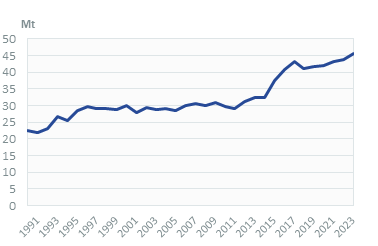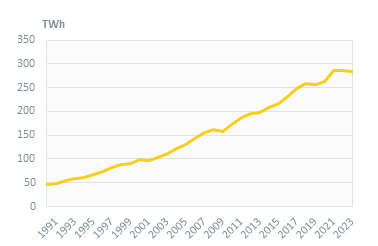-
-
 Energy and Climate Databases
Energy and Climate Databases- The most comprehensive and up-to-date annual energy database.
- Monitoring of technology providers in H2 supply chain.
- Monthly energy data on key energy markets.
- The most reliable and up-to-date power generation database.
- The essentials of LNG trade at your fingertips.
- Global monitoring of new and existing refineries.
- Analyse energy consumption and efficiency trends at world level. Benchmark countries.
- Have your database developed by a recognised expert of both energy and IT.
-
 Energy - Climate Forecasts
Energy - Climate Forecasts- Instant access to energy and emissions forecasts.
- Strategic, annual wholesale price projections backed by Enerdata's energy modelling expertise and our globally recognised POLES model.
- Wedges module showing a breakdown of the levers enabling to reduce emissions between two scenarios.
- Unique, independent projections of consumption by end-use.
- GHG Marginal Abatement Cost Curves.
- Benefit from proven models to draw your own energy scenarios and anticipate tomorrow’s challenges.
-
 Market Intelligence
Market Intelligence- 110 Energy and climate country reports
- A newsletter to receive the latest updates on evolving technologies and policies.
- Global energy news and analyses curated daily.
- Enerdata’s experts bring you the essentials about your market and competitors.
-
-
-
 Market Analysis
Market Analysis- Understanding key consumption trends and drivers across sectors.
- Granular and exclusive insight to address the most pressing business and strategic issues.
- Expertise in strategic and business intelligence, with fine-tuning to the market’s specificities.
-
 Energy - Climate Scenarios
Energy - Climate Scenarios- Providing the outlook of an energy commodity in mid to long term time horizons.
- Sector and driver specific energy demand forecasting.
- Assess the evolution of energy prices on the international and regional markets, as well as end-users prices.
- Enerdata guides you through pathways to reach climate targets.
- Supporting local authorities in their decarbonisation strategies.
-
 Climate Strategy and Policy Evaluation
Climate Strategy and Policy Evaluation- Cutting-edge quantitative tools and relevant indicators to monitor and evaluate evolutions on worldwide energy markets.
- Analysis of the most cost-effective options to reduce emissions.
- Quantified simulation and analysis of pledges for climate change negotiations.
- Breakdown and analysis of carbon markets.
- Enerdata guides you on the most beneficial policy or investment options.
- Turning climate objectives into concrete action plans.
-
 Training
Training- Understand different policy targets and measures on energy efficiency.
- How to measure energy savings?
- Energy Forecasting is a 2 days training to learn to design and interpret energy forecasts.
- Energy statistics training allowing to create energy balance with supply, transformation and consumption and understanding the international energy statistics regulations.
- Initiation to EnerMED level 1is the training to approach on the most powerful energy demand forecasting model.
-
-
Resource Centre
Turkiye Key Figures
- Population:
- 86.3 million
- GDP growth rate:
- 4.52 %/year
- Energy independence:
- 28.4%
Data of the last year available: 2023
- Total consumption/GDP:*
- 84.7 (2005=100)
- CO2 Emissions:
- 5.10 tCO2/capita
- Rate of T&D power losses:
- 10.6%
* at purchasing power parity
View all macro and energy indicators in the Türkiye energy report
Turkiye Related News
View all news, archive your new and create your own daily newsletters only on your topics/countries of interest with Key Energy Intelligence
Turkiye Related Research
Benefit from up to 2 000 up-to-date data series for 186 countries in Global Energy & CO2 data
A data overview is available in the global energy statistics app
Total Energy Consumption
Total consumption per capita is around 1.9 toe (2023) (of which around 3 300 kWh of electricity) compared to about 2.8 toe for the EU.
Total energy consumption remained stable in 2023 to 168 Mtoe. It contracted by 2% in 2022 because of substantial price hikes in transport and industry. Before that, it increased by over 8% in 2021, and had previously been stable at around 163 Mtoe over 2017-2020, in a context of low economic growth. Total energy consumption had been growing at a rapid pace between 2000 and 2017 (around 5%/year).
Interactive Chart Turkiye Total Energy Consumption
Benefit from up to 2 000 up-to-date data series for 186 countries in Global Energy & CO2 data
View the detailed fondamentals of the market at country level (graphs, tables, analysis) in the Türkiye energy report
Crude Oil Production
Türkiye covers only 13% of its total oil needs with a production of 5.1 Mt of crude oil (2023).
The total refining capacity of 0.8 mb/d is distributed over 6 refineries, including 2 large ones belonging to Tupras: Izmir and Izmit (0.2 mb/d each). The STAR refinery (0.2 mb/d) was completed in 2018 by Socar.
In 2023, net crude and oil product imports reached almost 57 Mt, close to the 2016-2019 average. The share of crude in that amount has surged to around 60% since 2019, from 43% in 2018, due to the STAR refinery starting operations.
Interactive Chart Turkiye Crude Oil Production
Benefit from up to 2 000 up-to-date data series for 186 countries in Global Energy & CO2 data
Additionally, for more detailed information on refineries, you can request a sample of our EMEA Refineries Dataset
Oil Products Consumption
Oil consumption increased by almost 4% to 46 Mt in 2023. It had been increasing regularly since 2018 (+2%/year in average), following a 4.5% drop in 2017 and a period of rapid growth between 2010 and 2017 (4.5%/year), driven by the transport sector.
Graph: OIL CONSUMPTION (Mt)

Interactive Chart Turkiye Refined Oil Products Production
Benefit from up to 2 000 up-to-date data series for 186 countries in Global Energy & CO2 data
Additionally, for more detailed information on refineries, you can request a sample of our EMEA Refineries Dataset
Natural Gas Consumption
Gas consumption slightly decreased in 2023 (-1.5%) to 51 bcm, after a significant 12% drop in 2022, driven by large price increases and reduced consumption from power plants. It had previously surged by 32% over 2019-2021, due to high economic growth and low hydropower availability.
Between 2000 and 2014, gas consumption grew very rapidly (9%/year), but growth since then has been lower and more chaotic, depending on gas-fired power generation needs and due to efforts to limit consumption through price hikes (notably in 2018 and 2019).
Interactive Chart Turkiye Natural Gas Domestic Consumption
Benefit from up to 2 000 up-to-date data series for 186 countries in Global Energy & CO2 data
Additionally, for more detailed information on the LNG trade, you can request a sample of our EMEA LNG Trade Dataset
Coal Consumption
Coal and lignite consumption dropped significantly (-17%) in 2023 to 107 Mt. It had been increasing by 15% between 2020 and 2022, reaching 130 Mt. In 2021, it rebounded to its 2019 level, following a 9% drop in 2020 due to decreased demand from power plants. Coal and lignite consumption rose by 8%/year over 2015-2019.
Of the total demand, 79% is used to produce electricity, 14% is consumed by industry, and the remainder is consumed by buildings.
Graph: COAL CONSUMPTION (Mt)
Interactive Chart Turkiye Coal and Lignite Domestic Consumption
Benefit from up to 2 000 up-to-date data series for 186 countries in Global Energy & CO2 data
View the detailed consumption trends at country level (graphs, tables, analysis) in the Türkiye energy report
Power Consumption
Electricity consumption remained stable in 2022 and decreased by 1% in 2023, to around 284 TWh after its 9% growth in 2021. Electricity consumption had been increasing slowly as from 2018, following a period of very rapid growth over 2010-2018 (over 5%/year).
Industry absorbs the highest share with 45%, followed by services (27%) and residential (21%). Transport accounts for 1%.
Graph: ELECTRICITY CONSUMPTION (TWh)

Renewable in % Electricity Production
The General Directorate of Renewable Energy of MENR is in charge of implementing policy on renewables.
As part of the National Energy Plan 2022-2035, renewables are expected to account for 75% of the new power capacity that will be commissioned and will make up 65% of total capacity in 2035 (58.5% in 2023).
Interactive Chart Turkiye Share of Renewables in Electricity Production (incl hydro)
Benefit from up to 2 000 up-to-date data series for 186 countries in Global Energy & CO2 data
Learn more about renewables in the European Battery Market Analysis
CO2 Fuel Combustion/CO2 Emissions
In its updated NDC (2023), Türkiye pledged to cut its GHG emissions in 2030 by 41% below a BAU scenario (compared to 21% in its initial NDC). This cut would limit GHG emissions to 695 MtCO2eq (incl. LULUCF), which still corresponds to a level around 60% higher than 2012 level. Türkiye also intends to peak its emissions in 2038 at the latest and achieve net zero by 2053.